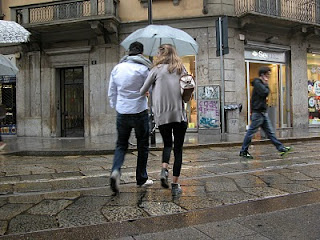
How much did you say that would be?
For a small (i.e., kitchen mug-sized) cup of normal American-style coffee in a cheapie disposable paper cup, no sugar, no milk, no squirts of who knows what, no nuthin', just coffee?
E. 2.10?! (that's $2.84 at today's exchange rate of almost $1.35 to one Euro!)...More......
O.K., O.K., O.K., Arnold's American Coffee...it's new, here, it's trendy, and, better--if memory serves--than much too bitter Starbucks (did I tell you I wrote them a few years back, telling them their coffee, in my opinion, is awful, and to forget their rumored introduction into the Italian market?), it's finally a decent cup of American coffee in Italy (though, I admit, a few months back I had a pretty good cup...the barman made an espresso, and just added extra water...not the same thing, though, folks...the roasting is different), just the right amount of bitterness with a bit of interesting smokiness, too.
O.K., O.K., O.K., there are chairs and tables and stools and, oh what the heck are they called, you know, a narrow high coffee bar kind of fixed nook table-like thing, and WiFi is free.
And they don't charge extra for sitting down.
At those prices, though, maybe I should say, they don't discount for standing, or using take away.
Gees!
Just to check to see if I'm way out of touch (apparently I am) with U.S. prices, I looked online.
According to Answers.com, the price for a similar cuppa in a similar café would be around $2.50 (http://wiki.answers.com/Q/How_much_does_a_cup_of_coffee_cost_in_US).
Yikes!
And I was complaining to myself about the rise of the price of an espresso, after the arrival of the Euro! It's half the cost of the American java.
And it's served in a nice porcelain cup and saucer, pre-warmed.
And, these days, the cafés often (though not always...don't try it at the "SKY" café at the Milanese Stazione Centrale...what a bad habit, charging customers just to sit for a few minutes, wake up, Italy!...and...the corollary...be nice, folks...drink your cuppa leisurely, but move along, move along, don't spend so little, then plant yourselves like a 1000-yr old Sequoia!) allow customers without charging extra to take their espresso to a table, and drink their cuppa calmly, though nicely bringing the cup and saucer back to the bar (you haven't paid for bussing service, after all).
Can someone please explain to me what the deal is with the, to me, exorbitant expense of a take away paper cup of coffee?









